Don't wanna be here? Send us removal request.
Text
WRITTEN REFLECTIVE ESSAY - “A LOOK BACK AT THE MODULE, AND WHAT WE’VE LEARNT”
[ 1,500 reflective written words as a PDF, text size 10. ]
OUTLINE - “AN OVERVIEW OF YOUR SPECIFIC AREA OF INTEREST”
“You will write a written reflective piece that analyses your skills and attributes.
It will identify your goals for working in the animation industry and explain how you will achieve them by outlining how you will focus the content of your future work and how you will promote yourself to the companies.“
FINAL GOODBYES
I’m a man who likes to have things wrapped up nicely, before moving on - be it in films, or television shows: an unsatisfying ending can really spoil what is otherwise an excellent experience, at least for myself.
We’ve come to the end of another module - and honestly: it’s been quite a journey.
I feel this particular module was extremely helpful; We learned essential skills, that better the way we work in aspects across all walks-of-life, and explored options to better help figure out the time-old-question of what it is that we want to do with our lives.
thank you, for reading through my ramblings - and ergo at least attempting to follow along with my thought process through this module, and heck - the university curriculum as a whole.
THE ESSAY
Write a reflective report on the area of the animation industry that you would like to work in. Commment on the skills required for that area
2D, Traditional-Drawn, animation is slowly but surely fading to irrelevance - in the eyes of the mainstream; as a dwindling art form; stuck falling subject to redundancy, as the process of animating becomes more and more streamlined.
But the art form will never truly die. Not, as long as passionate people keep putting in the laborious hours and pouring their hearts into overcome the odds and bringing life to the production of their projects.
it’s truly inspiring, and I wish to work amongst their ranks.
I originally came to university, in the hopes of learning the fundamental ideas that would teach me how to better my animations; and one and a half years in - my 2D skills, and understanding:
are arguably exactly where they were before I paid £9,250 a term. I’m aware of the fact that the industry is shifting to a more 3D-centric approach, and that the focus on teaching us primarily 3D modules as students it is to aid in employability statistics; so it’s through this particular module of the course that I’ve truly come to some understanding of how it is I, myself – would go about improving said skills, to get where I want to be in the industry.
Ideally, in a perfect world I would have followed my ambitions, with the desire to work my way through a few companies; to gather some experience in the way things in the industry run, build up contacts, and of course - have a stable salary, with set hours, as that’s as good of a life as you can ask for.
all this slow and steady progression so that in the end; I’ll wind up somewhere where I can work, with a team, on the production of my own animated series.
if it doesn't get picked up, by any networks - then quite honestly; I’ll just have to start my own animation company! As I’ve been working on this series, for almost 14 years now - so if I need to put all my eggs in one basket, I’m willing to sacrifice it all, for my artistic vision.
But all of that planning starts with me taking charge of my own professional development.
Which begs the question – what is it that I’m actually interested in doing?
Over the module, I looked at a variety of different job roles, offered across various companies, throughout all areas of the industry - and attempted to gain a little insight into not only the responsibilities they ensue – but the work they produce, the way they work, and the steps necessary to ensure a career in the future is as likely as possible.
Through my research, I’ve narrowed down my interests, and looked into a few areas of the industry that I have potential interest in finding work as, in the future. I’d like to aspire towards work as an animator, character designer, writer, concept artist or head of story – although my end goal is to become a producer.
Through my research I’ve also concluded that these positions are highly competitive, especially after just graduating – with no experience; so just having my degree, (as well as my obvious charm and charisma) won’t be enough.
Beyond having my degree in animation, once this course is terminated - I really need to start to home-in-on bulking up my portfolio with some more content; and that requires me allocating more time to the production of personal projects, outside of my university life.
Currently, I am on The Student Executive as Lead Welfare Representative for the Arts, Design and Social Sciences courses, am the Year 2 Animation Programme Representative, as well as a slew of personal commitments, such as practicing, performing and writing songs with my band. At such a stage of my professional life, it’s become extremely apparent the importance of not overworking oneself; and with all the commitments I’ve taken up this year, I’m going to need to cut time back from certain areas to give myself as best of a start on making some fresh content; to put into a more quality animated showreel; as much of my work, showcased was from years prior.
there’s nothing wrong with using old work, by any means - far from it! but I began animating at 13, and even used one of my animation tests, from the same year - which is clearly not the standard I should be holding for myself, at the point of which that I currently am.
as well as increasing the amount of work I have on show, beyond all my posters, sketchbooks, and scripts - I think it would be most beneficial to really develop myself, as an individual.
I plan to really develop my skillset, further: and rather than being a “Jack-of-All-Trades-Master-At-None” – I’d like to focus more time on the animation aspect of my work, as this is the skill, I feel needs the most work – in comparison to my pre-development stages, and other areas of interest.
Being too self-critical is a trait that most artists can be guilty of, myself included. This overly self-destructive set of thinking comes from the belief that you’ll never be good enough to get serious about what you’re doing – and I’m hoping that with the more focused production on this specific area of my life, that negative mindset will slowly begin to fade.
Another thing I’m considering, at the moment – which links into everything I’ve been saying about dedicating more time to actually animating – is that I would like to improve my social media presence, as at the moment myself and therefore my brand, are as unknown as the smallest integer. For a while, I’ve had my freelancing profiles shut down, so I can focus more on alternate aspects of my life – however, I think going back to freelancing as soon as I can may be the best option..
Not only will this give me the opportunity to build up a larger employment history, with more connections across various places but it will aid me in learning various sought-after skills, by individuals who have truly been in the game for longer than myself. who knows? Maybe I’ll even pick up a few tricks along the way!
I find the freedom of freelance exhilarating, yet terrifying: as no two projects are entirely the same, with different production teams – however the fear of an unstable income I’m fully reliant on, is a thought that keeps me up, in a cold sweat at night…
Overall, I think I’ve got a clearer idea of where I want to go – and how I’m going to get there, which I think was the true intention behind this module. not about the work produced, or the research undergone… except for the fact that we get marked on it; Okay! maybe it’s mostly about the content. But the point is that I set out to find what I want to do, and did just that. I’ve listed my goals – and really; what more could I ask for from this course?
Maybe some money back: because holy balls was that first semester not worth what we were paying!
0 notes
Text
“IKE-ILUS™” - WHAT KIND OF CONTENT DO YOU WANT TO MAKE?
sometimes you need to take a step back and really start questioning your life choices - seeing the holes in your plans, and using your burning passion to try patch them up
and whats the best way to deal with existential thoughts?
publicly vent about them, of course!
i started asking myself the questions you need to, once you get serious about a career choice - to make sure i really know what i want, so that when/if i make it into industry one day I know what to expect; and figured it could be fun to put those thoughts out there, in an interview-esque styled blog post that sort of humanises the stuff you see here
so here goes nothing: this is..
AN INTERVIEW WITH IKE PEARSON
WHO ARE YOU?
avoiding a sarcastic spiritual approach to this question, for the sake of moving on - I’m Ike: a fairly average 19 year old guy, from Westcliff, who lived in Abu Dhabi for the past 11 years - currently studying animation, at Northumbria University - to hopefully get a job, with a company; and maybe one day in the future: produce my own show.
that’s about the list of it.
WHAT PLATFORM DO YOU WANT TO CREATE CONTENT
I’ve always had a passion for 2D work - but over the past two years, I’ve been learning how to work in 3D, I think out of a necessity for the way the media is heading.
in a perfect world - I’d like to end up somewhere where I can work, with a team on my own series, using 2D, hand drawn-animation. to get there, though - I’d like to imagine that I’d have to build up quite a bit of experience, growing my network a tad; so I think the most honest that I can be is that I’d be happy anywhere that takes me.
WHAT STYLE OF EMPLOYMENT SUITS YOU?
I’ve done some freelancing, in the past - but due to low-fares I charged, believing anything more would be too much for thew quality of work I pump out, I stopped.
every time you have a new client you have to show them your work in a portfolio, adjusting the content depending on what the client is looking for
Starting salary of £21,000 going up to £28,000 Pros of freelance; independent, charge from £250 a day, no expensive workspaces, work from home, main investment is good internet and a high-end computer, work on a global basis, making animation content for companies, content with have a ‘shelf life’ of up to 4 weeks; new content will always be needed
being self employed is everyone’s ideal situation - being your own boss, working for different companies on particular assignments. heck - just having the freedom of being within a studio, or remote is enough to sell me on the idea - but I think in order to know for sure, I’d like to experience a bit of everything..
I’m not opposed to being in a collectives; as it expands your contacts, and decreases the workload on yourself - having more than one freelancer working together as a team, and all
but ideally I’d like to be employed by a company: because working for one company, for a salary with set hours is a stable income - and I think we can all agree, thats as good of a life as you can ask for.
WHAT ARE YOUR INTERESTS AND ASPIRATIONS WITHIN THE ANIMATION INDUSTRY?
if I can say it once; I’ll say it again~
Dream Big!
I want to work my way through a few companies, and gather some experience in the way things in the industry run, build up contacts, make money.. all of which are good
but I have aspirations of making a TV show one day. and if it doesn't get picked up - then heck; I’ll just have to start my own animation company! come up with a business plan, a cashflow forecast; (how to make the money, what to do with the money, etc.), and hire employees to help with the workload.
2D Traditional Animation is a media form that barely gets the recognition it used to, anymore - as there are more efficient processes in place for the production of entertainment. but I’d like to keep the flame from dying out - alive through a passion for the craft that sparked my interest in animation, to begin with.
WHAT SKILLS CAN YOU OFFER THE WORKPLACE?
Animation
Voice Acting
Music Production
Industry Knowledge
Animating
Character Designing
Concept Art
Video Editing
Illustration
Photography
Character Animation
Art
Writing
Storyboarding
Music Composition
Sketching
Tools & Technologies
Python (Programming Language)
Computing
Interpersonal Skills
Communication
Team Leadership
Teamwork
Problem Solving
Organization Skills
Organisation and planning
Initiative
Detail Oriented
Motivation and Enthusiasm
Other Skills
Rugby Union
Appreciation of Aesthetics
Ability to Express Ideas Through Drawings
WHO DO YOU WANT YOUR CLIENTS TO BE?
I mean - I’m not picky:
my ideal client would be anyone who would hire me
any income is a good income, as they say - and in my freelancing misadventures, in the past - I used my diverse skillset to do a variety of projects for colourful characters across all walks of life, and from that I can say that I don't really have a preference on the type of content I make, and therefore who i work for - as long as my work is of a decent standard, and I feel I’m deserving of the pay.
0 notes
Text
THE FUTURE - “HOW INCREASING SOCIAL MEDIA PRESENCE MATTERS”
ONLINE REPRESENTATION
The quality of your work is important but can be ruined by a poor online representation: Taking a look at your social channels every now and then is become increasingly more and more important in the current day - prompting you to ask yourself if they're employer-friendly. Employers DO look at a candidates social media channels to gauge whether they'd be a good fit for the job/company.
so it’s important to tidy up your social channels, by:
Adjusting your privacy settings. If you don't want recruiters to be able to see your profiles make sure they're set to private.
If profiles are public, delete any posts that could damage your chances of success - for example, wild holiday pictures or posts containing controversial comments or bad language.
Consider whether your profile handle looks/sounds professional. If not, change it.
do a spring clean on your personal sites; removing anything that you would feel embarrassed showing your employer in a job interview
separate business from social
start new sites using an appropriate suffix from your field of work
To improve your presence:
Follow organisations and professional bodies of interest to keep up to date with the latest news and developments.
Like, comment and interact with employers and peers.
When posting, include relevant hashtags to ensure your posts are seen by the right people.
Think about setting up separate work accounts.
KEEPING PRIVATE ACCOUNTS PRIVATE
in a lines of work where the audience spotlight is on the stuff you do; you need to set boundaries: keeping accounts that you consider private..
well..
private
for instance, with myself - accounts such as my personal SnapChat, Instagram, Discord, and Facebook are all things that I’d be uncomfortable adding strangers, and people who are not at least acquaintances on - so I tend to keep those usernames, and any information retaining to them private.
however, for accounts that I’m actively either trying to promote, or don't mind gathering a following on - it’s important to make it known where you are sited.
Instagram: https://www.instagram.com/squad_i_productions/
LinkedIn: https://www.linkedin.com/in/ike-ilus/
NewGrounds: https://ikeilus.newgrounds.com
Tumblr: https://ike-ilus.tumblr.com
Twitter: https://twitter.com/IkeIlus
YouTube: https://www.youtube.com/channel/UCW0N8Qd2DSxnSkroRwXyc7g
0 notes
Text
CRAFTING THE PERFECT CV - FORMULA FOR SUCCESS
landing the perfect gig can be difficult - and with as minimal job experience as I have had; it’s an intimidating world, out there: and finding work in it, doesn't need to be more difficult than it already seemingly is.
neglecting your CV is a common practice - but when the time comes to apply for jobs you'll wish you’d kept it up to date. If yours could do with a bit of TLC, now's the time to do it - because this blog post will cover some of the foolproof steps I’ve discovered showering the internet for tips..
PICKING A STYLE
when writing any sort of document - you want to put a little bit of visual flair in it, so it stands out; whilst keeping it simple, and of course professional - as this is a document after all
notice the exemplar CV below; the necessary information is formatted well, and it’s easy to read..
in every sense of the word - this is an excellent example of what to do for your CV

but notice our second example: where even a splash of subtle colour makes it a little nicer to read - with more personality and visual appeal to it.
it’s subtle changes like this, that don't effect the quality of your document, while still being interesting to view, and therefore more memorable that make a good CV.
but if you’re still not satisfied with changes as subtle as these...

our third example features a candidate who has reformatted the structure, in a visually appealing way that has its own perks, and showcases a level of technical skill.
the use of a picture makes it feel more personal, also - but most CVs don't require a picture, unless for modelling, acting, etc.

GATHERING THE NECESSARY INFORMATION: “WHAT DO YOU NEED”
the components that build up a CV differ from job to job, but essentially this is what you need:
you should take a look at writing a personal statement
putting necessary contact information, that you’re comfortable with them having
your places of education, and the qualifications you received from there
your employment history
a set of achievements, or hobbies can go a long way
If you take up any of those employability-boosting activities, online don't forget to add those skills and experiences to your CV.
ACTUALLY WRITING THE DARN THING
get some help, and believe me when i say there’s a lot of help out there, here’s a list of references for sites I, personally used in the production of my’n:
https://www.theguardian.com/culture-professionals-network/culture-professionals-blog/2012/mar/15/cv-tips-first-arts-job
https://www.topuniversities.com/blog/7-simple-effective-ways-make-your-cv-stand-out
https://www.prospects.ac.uk/careers-advice/cvs-and-cover-letters/how-to-write-a-cv
https://www.totaljobs.com/advice/successful-cv
https://www.thecvstore.net/GoodCV.htm
https://worksmart.org.uk/what-makes-good-cv
https://career-advice.jobs.ac.uk/academic/how-to-write-a-good-cv/
FINAL CHECKS - “SCRAPING OFF THE GUNK AND CLUTTER”
it’s important to spend time casting a critical eye over your CV, from the perspective of an employer.
Does it contain unnecessary or inaccurate information? Is it formatted correctly? Does it include all your skill and experience? Could you personal statement do with a rewrite?
Keep an extra eye out for errors or typos - as that’s one of the most common issues that can leave an employer feeling like you’re unprofessional enough to let slip-ups like that make it’s way into your official documentation
0 notes
Text
READING
“The Fundamentals of Animation” Paul Wells
storyboarding is “the key aspect of the visualisation process” acting as a link between the script and soundtrack, in the later stages of production.
Oxford Dictionary defines a ‘storyboard; as:
“a sequence of drawings, typically with some directions and dialogue, representing the shots planned for a film or television production.”
so, in essence - storyboarding is a way of telling the viewers a story, in a visual medium.
when content producers are asked to create a project, (whether its film, an animation, etc.) they use storyboards to show either their client (or themselves) the way they intend to make the final product look, before actually producing work; in order to limit the amount of time wasted from animators having to redo shots, because of unsatisfactory results.
its within the storyboarding process that we can use creative design to visually link to the narrative; literally converting the story into pictures.
his writing also references that there can be three stages to the storyboarding process:
the thumbnail stage
the reference stage
the fixed stage
Prepare to board!: creating story and characters for animated features and shorts by Nancy Beiman
Of course, no book about storyboarding would be complete without a rundown of the basic concepts of cinematic storytelling: camera angles, lenses, and composition.
This book describes visual storytelling and design methods developed during the “Golden Age of Animation’ and still in use today.
The first part of this book talks mostly about developing story content, whereas technique is discussed in the second part, and the third part deals with the presentation of the story and artwork before an audience
as Roy Disney pointed out: “Some people say that story is the only thing that matters in animated film.”
I agree. Good animation, and good design never saved a bad story.
Strong characters can make a weak story tolerable and a good story better, but characters develop within a story context. Each depends upon the other.
Story works out of and depends on your experience, imagination, and skill. There is no software that will think up good situations or draw good storyboards for you.
but basic design principles remain constant: A well-drawn character will translate into a well-designed puppet or digitally generated character.
The principles described in the book’s character design sections are intended for use in all media.
Eighty percent of an animated film’s production time is spent in developing the story, art direction, and designs for the characters (pre-production). The other 20 percent is spent on the actual animation production and post-production.
Outlines, scripts, and storyboards for television, feature-length, and short animated films differ greatly from one another.
MISC WORKS.
a good filmmaker; (animated or not) knows that anyone can tell a story. but its the way you tell it that leaves an impression
“(an effective composition is) one that can be seen to communicate visual sense, and direct the viewers attention towards the aspects that the maker wants (them) to see” Nelson Diplexcito,
steps to storyboarding:
Define your goals. Brainstorm your ideas. Create a timeline for your story. Begin sketching. Include Additional Notes. Seek a second opinion. Revise the storyboard.
0 notes
Text
RESEARCHING STORYBOARD ARTISTS
in order to talk about storyboarding - I think it’s important to put some names to work; which is what sometimes goes unnoticed in our field - so today I set out to find some story-board artists I like, through their work.
Joseph "Joe" Roland Barbera (March 24, 1911 – December 18, 2006)
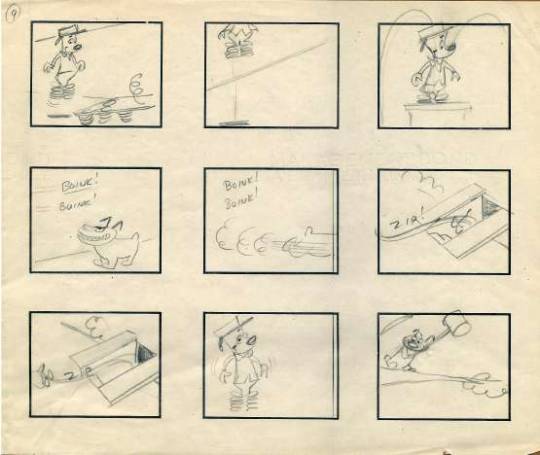
an American animator, director, producer, storyboard artist, and cartoon artist, who co-founded the animation studio and production company Hanna-Barbera.
Hayao Miyazaki / 宮崎 駿 (January 5, 1941)
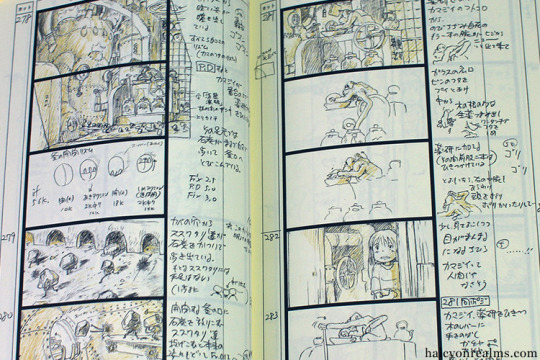
a Japanese animator, director, producer, screenwriter, author, and manga artist, who co-founded Studio Ghibli, and has attained international acclaim as a masterful storyteller and creator of Japanese animated feature films, and is widely regarded as one of the most accomplished filmmakers in the history of animation.
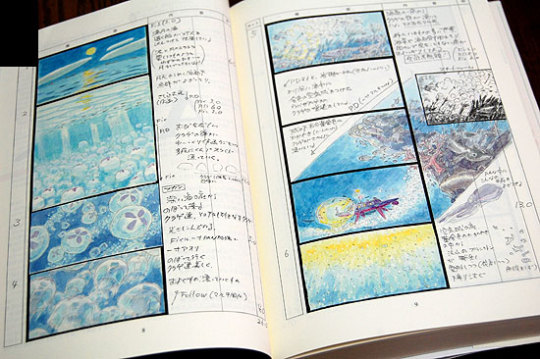
Elmer Earl "Butch" Hartman IV (January 10, 1965)
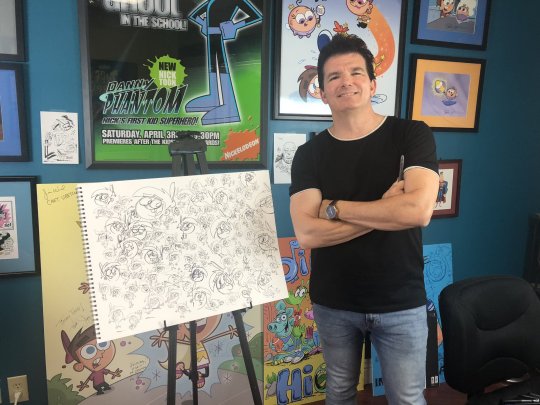
is an American animator, writer, producer, director, and voice actor; best known for creating Nickelodeon's The Fairly OddParents, Danny Phantom, T.U.F.F. Puppy, and Bunsen Is a Beast.
Jeff "Swampy" Marsh (December 9, 1960)
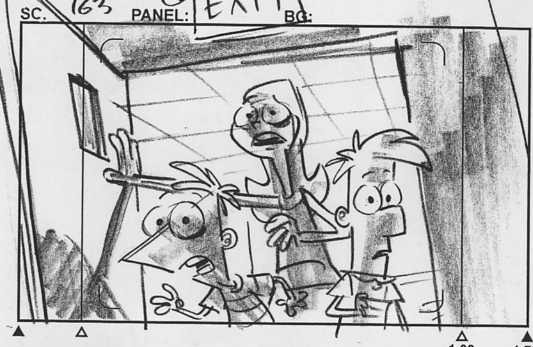
an American animator, writer, director, producer, and voice actor associated with several animated television series, most notably as an executive producer and the voice of Major Monogram for Disney's animated series Phineas and Ferb and Milo Murphy's Law,
Marsh has been and continues to be a driving force behind several animation projects, working for over six seasons on the animated television series The Simpsons. Marsh continued to work on other animated television series, including King of the Hill and Rocko's Modern Life, before moving to England in 1996.
Rebecca Rea Sugar (July 9, 1987)

an American animator, director, screenwriter, producer, and singer-songwriter. best known as the creator of the Cartoon Network series Steven Universe,
Until 2013, Sugar was a writer and storyboard artist on the animated television series Adventure Time. Her work on the two series has earned her seven Primetime Emmy Awardnominations.
Sugar is bisexual and non-binary, using both she/her and they/them pronouns, which has served as the inspiration for her to stress the importance of LGBT representation in art, especially in children's entertainment.
HOW TO GET INTO STORYBOARDING (FOR CHEAP!) - ALEX DAVY
Alex is a storyboard artist for animation and illustrator born in London and living in Newcastle, UK.
Alex trained with Bluezoo in London, completing story tests for Locksmith film studio, and boards on children’s animated TV across 2D, 3D and Stop-motion shows. Alex’s storyboarding style is humour-focused with an emphasis on adding in as many daft character moments as possible. Alex has spoken at most local universities including Newcastle, Sunderland, and Northumbria university.
Alex Woo's Gesture course on @SchoolismLIVE - £20 p/m ish Pixar-In-A-Box on @khanacademy - free!
2-3 hours Urban sketching (watching people from a cafe window) every weekend - price of a few coffees
4-5 story books recommended from @Tallychyck's list (£40 ish)
Time management! 8pm every night was committed story practice (drawing personal boards or an Alex Woo class mostly)
Listening to animation podcasts on my lunchbreak Practice
thumb-nailing out a film on telly, rather than just watching it
subscribing to @thelindsayellis for amazing free film studies essays on your favourite animated movies
travel to meet inspiring directors or heads of story, face-to-face chats are invaluable! (£150 flight to Bristol for a 3hr chat and portfolio review!)
thumbnail other’s work - storyboard in a notebook in pen. Studying others peoples work who are better than me did SO MUCH to help me see my mistakes! (Obviously dont steal it, this is just for learning!)
5 notes
·
View notes
Text
RESEARCH METHODS
effectively researching can be difficult, without knowing how to do it: in this blog post, I’ll attempt to cover some of the most prominent methods of research.
PRIMARY SOURCES VS SECONDARY SOURCES https://umb.libguides.com/PrimarySources/secondary
( for animation this would be stuff like journals, documentaries, conferences and special interests groups )

ACTION BASED RESEARCH practice-based: making things to find things out
FIELDWORK
Experiments
People who take part in research involving experiments might be asked to complete various tests to measure their cognitive abilities (e.g. word recall, attention, concentration, reasoning ability etc.) usually verbally, on paper or by computer. The results of different groups are then compared. Participants should not be anxious about performing well but simply do their best. The aim of these tests is not to judge people or measure so-called intelligence, but to look for links between performance and other factors. If computers are used, this has to be done in such a way that no previous knowledge of computers is necessary. So people should not be put off by this either.
The study might include an intervention such as a training programme, some kind of social activity, the introduction of a change in the person’s living environment (e.g. different lighting, background noise, different care routine) or different forms of interaction (e.g. linked to physical contact, conversation, eye contact, interaction time etc.). Often the interaction will be followed by some kind of test (as mentioned above), sometimes before and after the intervention. In other cases, the person may be asked to complete a questionnaire (e.g. about his/her feelings, level of satisfaction or general well-being).
Some studies are just based on one group (within-group design). The researchers might be interested in observing people’s reactions or behaviour before and after a certain intervention (e.g. a training programme). However, in most cases, there are at least two groups (a between-subjects design). One of the groups serves as a control group and is not exposed to the intervention. This is quite similar to the procedure in clinical trials whereby one group does not receive the experimental drug. This enables researchers to compare the two groups and determine the impact of the intervention. Alternatively, the two groups might differ in some important way (e.g. gender, severity of dementia, living at home or in residential care, etc.) and it is that difference that is of interest to the researchers.
Surveys
Surveys involve collecting information, usually from fairly large groups of people, by means of questionnaires but other techniques such as interviews or telephoning may also be used. There are different types of survey. The most straightforward type (the “one shot survey”) is administered to a sample of people at a set point in time. Another type is the “before and after survey” which people complete before a major event or experience and then again afterwards.
Questionnaires
Questionnaires are a good way to obtain information from a large number of people and/or people who may not have the time to attend an interview or take part in experiments. They enable people to take their time, think about it and come back to the questionnaire later. Participants can state their views or feelings privately without worrying about the possible reaction of the researcher. Unfortunately, some people may still be inclined to try to give socially acceptable answers. People should be encouraged to answer the questions as honestly as possible so as to avoid the researchers drawing false conclusions from their study.
Questionnaires typically contain multiple choice questions, attitude scales, closed questions and open-ended questions. The drawback for researchers is that they usually have a fairly low response rate and people do not always answer all the questions and/or do not answer them correctly. Questionnaires can be administered in a number of different ways (e.g. sent by post or as email attachments, posted on Internet sites, handed out personally or administered to captive audience (such as people attending conferences). Researchers may even decide to administer the questionnaire in person which has the advantage of including people who have difficulties reading and writing. In this case, the participant may feel that s/he is taking part in an interview rather than completing a questionnaire as the researcher will be noting down the responses on his/her behalf.
Interviews (interviews & secondary interviews)
Interviews are usually carried out in person i.e. face-to-face but can also be administered by telephone or using more advance computer technology such as Skype. Sometimes they are held in the interviewee’s home, sometimes at a more neutral place. It is important for interviewees to decide whether they are comfortable about inviting the researcher into their home and whether they have a room or area where they can speak freely without disturbing other members of the household.
The interviewer (which is not necessarily the researcher) could adopt a formal or informal approach, either letting the interviewee speak freely about a particular issue or asking specific pre-determined questions. This will have been decided in advance and depend on the approach used by the researchers. A semi-structured approach would enable the interviewee to speak relatively freely, at the same time allowing the researcher to ensure that certain issues were covered.
When conducting the interview, the researcher might have a check list or a form to record answers. This might even take the form of a questionnaire. Taking notes can interfere with the flow of the conversation, particularly in less structured interviews. Also, it is difficult to pay attention to the non-verbal aspects of communication and to remember everything that was said and the way it was said. Consequently, it can be helpful for the researchers to have some kind of additional record of the interview such as an audio or video recording. They should of course obtain permission before recording an interview.
Case studies
Case studies usually involve the detailed study of a particular case (a person or small group). Various methods of data collection and analysis are used but this typically includes observation and interviews and may involve consulting other people and personal or public records. The researchers may be interested in a particular phenomenon (e.g. coping with a diagnosis or a move into residential care) and select one or more individuals in the respective situation on whom to base their case study/studies. Case studies have a very narrow focus which results in detailed descriptive data which is unique to the case(s) studied. Nevertheless, it can be useful in clinical settings and may even challenge existing theories and practices in other domains.
Participant and non-participant observation
Studies which involve observing people can be divided into two main categories, namely participant observation and non-participant observation.
In participant observation studies, the researcher becomes (or is already) part of the group to be observed. This involves fitting in, gaining the trust of members of the group and at the same time remaining sufficiently detached as to be able to carry out the observation. The observations made might be based on what people do, the explanations they give for what they do, the roles they have, relationships amongst them and features of the situation in which they find themselves. The researcher should be open about what s/he is doing, give the participants in the study the chance see the results and comment on them, and take their comments seriously.
In non-participant observation studies, the researcher is not part of the group being studied. The researcher decides in advance precisely what kind of behaviour is relevant to the study and can be realistically and ethically observed. The observation can be carried out in a few different ways. For example, it could be continuous over a set period of time (e.g. one hour) or regularly for shorter periods of time (for 60 seconds every so often) or on a random basis. Observation does not only include noting what happened or was said but also the fact that a specific behaviour did not occur at the time of observation.
Observational trials
Observational trials study health issues in large groups of people but in natural settings. Longitudinal approaches examine the behaviour of a group of people over a fairly lengthy period of time e.g. monitoring cognitive decline from mid to late life paying specific attention to diet and lifestyle factors. In some cases, the researchers might monitor people when they are middle-aged and then again after 15 years and so on. The aim of such studies is usually to determine whether there is a link between one factor and another (e.g. whether high alcohol consumption is correlated with dementia). The group of people involved in this kind of study is known as a cohort and they share a certain characteristic or experience within a defined period. Within the cohort, there may be subgroups (e.g. people who drink moderately, people who drink heavily, people who binge drink etc.) which allow for further comparisons to be made.
In some cases, rather than following a group of people from a specific point in time onwards, the researchers take a retrospective approach, working backwards as it were. They might ask participants to tell them about their past behaviour, diet or lifestyle (e.g. their alcohol consumption, how much exercise they did, whether they smoked etc.) They might also ask for permission to consult the participants’ medical records (a chart review). This is not always a reliable method and may be problematic as some people may forget, exaggerate or idealise their behaviour. For this reason, a prospective study is generally preferred if feasible although a retrospective pilot study preceding a prospective study may be helpful in focusing the study question and clarifying the hypothesis and feasibility of the latter (Hess, 2004).
Studies using the Delphi method
The Delphi method was developed in the United States in the 1950s and 1960s in the military domain. It has been considered particularly useful in helping researchers determine the range of opinions which exist on a particular subject, in investigating issues of policy or clinical relevance and in trying to come to a consensus on controversial issues. The objectives can be roughly divided into those which aim to measure diversity and those which aim to reach consensus.
Different ways to employ this method have been devised but they tend to share common features, namely a series of “rounds” in which the participants (known as “panellists”) generate ideas or identify salient issues, comment on a questionnaire (constructed on the basis of the results from the first round) and re-evaluate their original responses. After each round, a facilitator provides an anonymous summary of the forecasts/opinions made by the experts and of their reasons.
There is no limit to the number of panellists involved but between 10 and 50 might be considered manageable. The panellists are chosen on the basis of their expertise which could take many forms (e.g. academic, professional or practical knowledge, personal experience of having a condition, being a service user etc.).
0 notes
Text
VIDEO ESSAY FORMATS
as a creator; you have an urge to put your own spin on your content to differentiate from the others doing the same thing, in what can only be described as a soulless and oversaturated market
the best way to do that is to put a little bit of yourself into what you make!
and when you’re an unlikeable prick, with 0 personality: you have three options..
better yourself through self-reflection, (and or imitating the positive qualities you admire from inspirational people in your life) to make positive changes that evoke a positive reaction from your friends, loved ones and peers
learn to love yourself as you are, flaws and all
lie
as they say - imitation is the most sincere form of flattery - so why not start off with looking at the way some people present themselves, within their own video-essay content
SCOTTHEWOZ

Scott The Woz is a comedic video game centric variety show that focuses on reviews, editorials, retrospectives, and much, much more.
I’ve been a fan of Scott Wozniak (full name: The guy who owns Sonic Jam, Scott Climax Scatt "Daniel""Resourceful" "Will Eventually Take a Look at the First Mega Man""Your Next Employee""W.E.T.A.L.A.T.F.M.M.""Scott the Woz" Buff Wazniak Wozniak (working title) and his series, for quite a while - finding myself drawn in by Wozniak’s style of comedy, as it’s incredibly appealing - with him combining skits, and offbeat humour with informational and opinionated insight into usually quite unknown topics.
Scott isn't the type to shy away from committing to a bit, with an impressive array of in-universe-continuity; that fans of the series fondly reference amongst one another.
youtube
JONTRON

an American YouTuber, commentator, comedian, and reviewer known for his reviews of retro, odd, and bad video games and movies.
He reviews video games, movies, and television shows of varying genres in a retrospective and comedic manner in his YouTube web series JonTron. Jafari was co-creator and former co-host of the Let's Play web series GameGrumps before his departure on June 25, 2013, and co-created the video game entertainment website NormalBoots.
PEANUTBUTTERGAMER

an American gaming YouTuber and reviewer. PBG is very well-known for his Top 10s, Game Reviews, and "Hardcore" series
PYROCYNICAL

Pyrocynical (or simply Pyro), is an English YouTuber who uploads various types of commentary and analysis videos, especially those featuring trend-related content, on his channel.
VIDEOGAMEDUNKEY

an American YouTuber known for his YouTube skits and video essays that blend crude humor with video game criticism
DOWN THE RABBIT HOLE
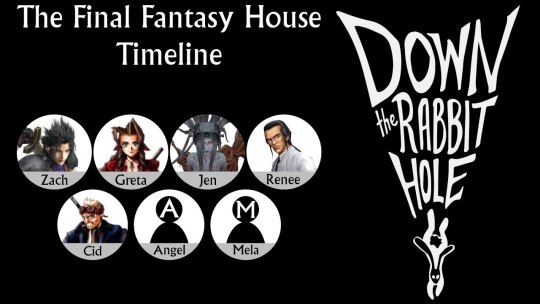
Fredrik Knudsen is a commentary YouTuber best known for his "Down the Rabbit Hole" documentary series, which explores a wide variety of subject matters, mostly relating to strange phenomena either in real life or on the internet.
BETA64

a gaming YouTuber known for his documentaries on the development of Nintendo games.
By analysing content leftover in video game files and marketing, as well as through researching old interviews with Nintendo developers, Andrew is able to explain and sometimes visualise scrapped or changed ideas from a video game's development. This allows the audience, in turn, to understand how the final game came to be what it is, and how it could have potentially ended differently.
AVGN

American retrogaming review comedy web series created by and starring James Rolfe. The series centers on Rolfe's titular skit character, often simply shortened to "the Nerd", a short-tempered and foul-mouthed gamer who delivers commentary on retro games of poor quality. While the series began with Rolfe simply playing games while delivering a running commentary, the show would eventually grow in scope to encompass sketches featuring guest characters, reviews of gaming consoles and peripherals, and short lectures about video game history and culture.
NOSTALGIA CRITIC

Nostalgia Critic is an American review comedy web series created, directed by and starring web comedian Douglas "Doug" Walker. The series initially launched on YouTube on July 3, 2007, before moving to Walker's own site, That Guy with the Glasses, then to Channel Awesome. The show follows Walker as the title character, a bitter and sarcastic critic who mostly reviews films and television shows from his childhood and recent past, usually with comically exaggerated rage. The show often alternates the Critic's angry rants and humour with analysis of the episode's subject.
1 note
·
View note
Text
FINALLY CHOOSING THE TOPIC OF THE ESSAY
when you’re set an open task - it can be almost as difficult to work on, than a restricting one, where you have no creative input.
for my research report, I thought about an area of the animation industry, that I’m quite fond of the idea of potentially working on:
STORYBOARDING
but for the sake of holding the audience’s interest - instead of solely discussing the technique, I figured I’d like to discuss the way in which the product can change drastically, through later stages of the production process.
Examples of how different final product can be from original scopes
youtube
youtube
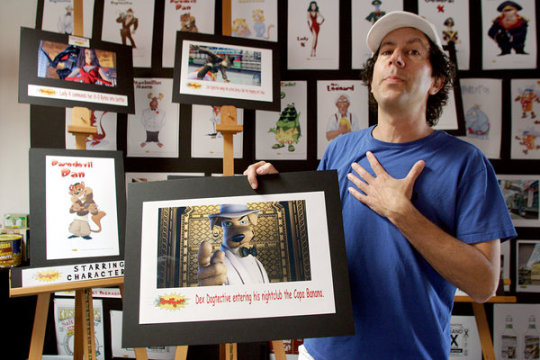
with so many productions having such vastly different scopes, so late into production - from the what the audience is shown: there’s plenty of content for me to cover in a ten minute video essay.
I think it’s really important to acknowledge the changes that occurred to get from the original idea, to the finished product - as it helps us, as the audience understand the creative process a little better; and in some cases see an alternative story, to the one we’ve been told.
0 notes
Text
ENHANCING EMPLOYABILITY
“being employable”...
we all hear that it’s important - but less common so is hearing how we’re supposed to achieve such a task.

being employable is a simple combination of variables, that come together to showcase your worth as a professional individual;
the quality of your work is especially important - in a field such as our own; where you need to showcase a diverse set of skills and a passion for the subject. ( For better job prospects, a degree or diploma in animation, also helps... )
some of these essential skills, for a career in animation include:
Creativity
Sketching
Good Visual Imagination
Knowledge of CAD
Good Colour Sense
Artistic Skills
Appreciation of Aesthetics
Ability to Express Ideas Through Drawings
Detail Oriented
Computer Skill
Regardless of the line of work you enter, professionalism and integrity are important skills to master.
- Join professional networking groups and leadership development programs. - Take your business life seriously and learn how to effectively manage your time and deal with work pressures. - Familiarise yourself with people in your industry whose level of professionalism you respect and work to emulate their action and behaviours.
ETHICS AND INDUSTRY - “UNDERSTANDING PROFESSIONALISM”
the workplace is a place where you work you have to present yourself in a professional manner, whilst still maintaining a sense of who you are
Employers, fellow employees and customers all expect a high level of professionalism. For this reason, being professional can help you to achieve your goals and advance your career.
We’ve all heard the word “professionalism,” and we know it’s tied to being professional - but what exactly does that mean?
WHAT IS PROFESSIONALISM “the conduct, aims, or qualities that characterise or mark a profession or a professional person.”
Said another way: the way you carry yourself, your attitude, and the way you communicate with others - so dressing professionally, being punctual, having integrity, staying calm, and collected are generally considered displays of professionalism
as the famous adage goes: “Think about where you want your career to go and act like you’re already there.”
Professionalism is having the skill, knowledge and confidence to perform a job to the highest standards that might be expected of you. Being professional can mean different things depending on the employer or industry, and the confidence, knowledge or skill expected in one role might not be the same in another.
a lot of people struggle so much so with this they have a separate persona for work, but it all comes down to a few basic attributes:
ATTRIBUTES OF PROFESSIONALISM
[ https://www.umassglobal.edu/news-and-events/blog/professionalism-and-workplace-etiquette ]
BEING KIND - “DON’T BE A DICK”
as a person who’s known to be very sarcastic and blunt - with a respect for getting straight to the point in a no nonsense manner:
i like this rule
you never know what people have got going on in their lives
that includes talking about people behind their back, and gossiping who knows: it might be pretty humbling
USE APPROPRIATE LANGUAGE
nobody ever wants to hear sexist, ableist or sexist comments at work.. or ever really
HOW ELSE CAN I BE MORE EMPLOYABLE?
not satisfied with what we’ve talked about?
worry not!
Ike always comes prepared with a few more tips, from research:
ADVANCE YOUR EDUCATION
Training and education show potential employers that you take your professional life seriously.
You can advance your education and improve your employability skills by getting a degree or certification, completing continuing education courses or participating in internships and work-study opportunities. You can also find a mentor, participate in professional development opportunities or join trade or industry associations that provide enrichment programs to improve job skills.
GET ORGANISED
Organisational skills are vital to enhance your career and employability skills.
Improving your employability skills starts with yourself making the active initiative to do something about it: volunteering to take leadership or coordinator roles in your workplace or community. Participating in long-range planning initiatives, strategic planning sessions or event management all of which can help you hone your skills in this arena.
LEARN TEAMWORK SKILLS
The ability to perform well with colleagues is one of the most sought-after traits by employers: if you can't work in a team, what good are you on their team, after all?
You can develop your own teamwork skills by participating in steering committees, boards and councils or volunteer groups.
heck - in some cases; you can flat out request assignment to group projects or to participate in professional development seminars and other programs that focus on building teamwork.
IMPROVE YOUR COMMUNICATION
Verbal and written communication skills are important in nearly every business or industry.
You can improve your employability skills in this area by participating in public speaking forums such as Toastmasters, or volunteering to be a group spokesperson for a program or event.
BECOME SELF MOTIVATED
Employees who are self-motivated and self-reliant are valuable assets to employers.
now you might think you’re clever by asking
How do we show EMPLOYERS this, if it’s being done for your SELF?
well - developing your own personal and professional goals is just something most people can appreciate - if you set out objectives and develop a course of action for achieving them: then you’re obviously going to be an invaluable asset.
Requesting regular performance reviews and asking for input on how you can improve your skill sets and enhance your work product is a start - but again, Take the initiative on projects and meet deadlines without fail: and you can never steer wrong!
0 notes
Text
STUDIO RESEARCH - “WHAT OTHERS HAVE DONE”
for myself: this course has sort of rattled what my initial, outsider perspective, of what it is i want to do in the future.
if you’ve been following along through my initial blogs, I elaborated a little on how I would like to eventually pitch a show to a network, and work on that full-time.
not that i don't still want to do that,
far from it!
but there’s so many areas of the animation industry that I hadn't even considered before; and I think over this module - I’d like to at least look into the possibilities and weigh out my options, as my skillset could better suit a different role than being exclusively an animator, and where I could see myself working one day..
we were asked to research on company's we would like to work in.
and I figured to start, it was time to expand my knowledge and research some: the following is a list of companies I came across that I like, and later on in the post I’ll expand upon a list of companies I would like to see myself working with, if the opportunity ever arises.
THE VIDEOGAME INDUSTRY
UBISOFT
although not something I’m particularly interested in working in, myself - the video game industry is where the future seems to be heading; and as much as i prefer playing, than creating - its indisputable, that they’ve made some pretty amazing content, in the past few years
PIKPOK http://pikpok.com/careers/
New Zealand is a pretty amazing place - heck; they filmed Lord of The Rings there, that’s about the best compliment I can give it.
ANIMATION & DESIGN
KINGBEE https://www.kingbee.co.uk/elements/our-work/
STUDIO LIDDELL https://www.studioliddell.com
SEED ANIMATION https://www.seedanimation.com/work
ALEX DAVY STORYBOARDS & ILLUSTRATION http://www.alexdavy.net
FEED ME LIGHT https://feedmelight.com
THREEMOTION https://threemotion.co.uk
THE ANIMATION GUYS https://www.theanimationguys.com/contact/
KURO ANIMATION https://kuroanimation.com
BLUE KANGAROO https://www.bluekangaroodesign.co.uk
POSHGECKO https://poshgecko.co.uk/animation-company/?device=c&keyword=animation%20company&adgroup=89863935972&network=g&gclid=Cj0KCQiAoNWOBhCwARIsAAiHnEiM1JdJd6tEJV4VI_z2yNxynlkxjhSZhobb43DqVa_vaEMcI-PLrS4aAk1pEALw_wcB
HOW TO GET TO WHERE YOU WANT TO WORK?
KNOWING WHAT YOU WANT : of course, before you can get yourself going anywhere - it’s important to know what sort of work you want to do;
WHAT STYLE OF EMPLOYMENT, WORKS FOR YOU?

AUDIENCE - “HOW DETERMINING YOUR PREFERRED TMA CAN ENHANCE EMPLOYABILITY”
‘Home-grown successes that have hit the international market include Wallace and Gromit, Bob the Builder, Mr. Bean and Peppa Pig. Over a quarter of children’s TV programming is animation.’
knowing who you want to make content for, is a great step toward knowing who you’d like to work for - as different companies specialise in what they produce for, and therefore what you would be creating, also.
PLATFORMS
much ike how different companies produce for different audiences - they also usually produce content for specific types of platform; be that theatre, advertising, television, film, etc.
once you’ve figured out the basic components of what you want, you can begin creating the content, and booking the necessary meetings to advance yourself toward the position
RESUME : Your resume will be your first impression. Your resume needs to stand out for the employers to be impressed. In high-profile jobs like these, a formal degree does not matter as much as your experience and practical work does. You should have some work experience mentioned in your resume in the field of animation. In jobs like that of animations for a cartoon show, you need to have a knack for details and good organizational skills. To make your mark, it is also recommended to have some training or experience in the production field. Such extra training makes you better than others, giving you a higher chance of getting the job.

COVER LETTER : This is an extension of the resume where you discover yourself and let the employer know you and your passion. They already know about your work experience through your resume. Thus, your cover letter is the place where you talk about why you like the field of animation, why you want to work with Cartoon Network, what are your career goals, etc. You can choose to be a bit friendly in your tone and talk about your passions and what you will be able to bring to the studio. Even if you do not have a lot of experience in the field, your cover letter is the place where you can prove yourself to be worthy. If you can convey through your cover letter that you are someone truly interested in the field and are an eager learner, you’ll be one of the favorites.
FILMMAKING https://wimpykid.com/wp-content/themes/wimpykid/webroot/documents/WKMovieTeachingGuide.pdf
INTERVIEW : After your applications, you have your interviews. There are videos as well as in-person interviews. For both of them, it is important to remember that you are an individual, not a machine. You can have casual interviews and you get a chance to talk about yourself. Talk about your goals, ambitions, passion, and your expectations. The interviews give both the parties involved, an opportunity to judge whether they will fit in with the company. It is better to be yourself rather than having the correct answers or the expected answers. You’ll have a greater chance to stand out if you offer something different to the studio, something most people cannot. This is something you’ll be able to do only if you portray your personality and not some predetermined behaviour.
Warner Bros. - Turner Entertainment, Cartoon Network

Jobs at Cartoon Network are very competitive, but I believe that working with a reputed company like Cartoon Network should be one of your goals, if you are in these fields.
go big or go home, after all~
To become an animator at Cartoon Network Studios, it is advised to have a degree in design, fine arts, or animation. Along with that, applicants also need to have their portfolios with their animated reels.
It means that a person can get hired by the company if their portfolio is exemplary, even if they do not have a formal degree in the field. Nevertheless, some exposure and training in the field are required.
THE PROCESS
To apply for any job, you have a standard process that all companies put across beforehand. For all those wishing to apply to any job position at Cartoon Network, this is the process you need to follow –
Visit the official website of Cartoon Network
The website has a section about the careers at the company. Click on that option and get directed to the jobs available at the company at that time
[ https://www.cartoonnetworkstudios.com/jobs ]
The information about the jobs is presented on the website in the form of a list. This list is updated as and when the requirements arise
Once you find the job you want on the list, you can click on it to find the application for the same
Fill in the application and wait for the employers to contact you if they select you for the position
If your application is selected, you will be called for an interview after which you can be selected for the position
TWOFOUR54
TwoFour54 is a media and entertainment production company located in Abu Dhabi, United Arab Emirates that operates several production facilities, houses media companies and freelancers
https://www.twofour54.com/en/careers/
now I’m sure I can already hear you hypothetically judging me “Ike, this is a pretty obscure second choice, on the list..”
well - i DO think things through, before writing them down, i swear!
Abu Dhabi is the ideal location for business due to its stable, thriving economy, its emphasis on innovation, AND its central location between Asia and Europe, with direct flights to all major cities, make it easily accessible and the ideal location for business.
ARCUS STUDIOS
https://arcusstudios.co.uk
0 notes
Text
PROFESSIONAL CODES AND REGULATIONS
NDA
(non disclosure agreement)
also known as a confidentiality agreement: a non-disclosure agreement is a legally binding contract that establishes a confidential relationship - where the parties signing the agreement agree that sensitive information they may obtain will not be made available to any others.
IP (intellectual property)
an intellectual property is a category of property that includes intangible creations of the human intellect.
There are many types of intellectual property, and some countries recognize more than others. The most well-known types are copyrights, patents, trademarks, and trade secrets.
DATA PRIVACY & GDPR (general data protection regulation)
The General Data Protection Regulation (GDPR) is the toughest privacy and security law in the world.
Though it was drafted and passed by the European Union (EU), it imposes obligations onto organizations anywhere, so long as they target or collect data related to people in the EU.
HEALTH AND SAFETY RULES
regulations and procedures intended to prevent accident or injury in workplaces or public environments.
ON SET HEALTH AND SAFETY RISK MANAGEMENT
Risk management is the identification, evaluation, and prioritization of risks followed by coordinated and economical application of resources to minimize, monitor, and control the probability or impact of unfortunate events or to maximize the realization of opportunities
OCCUPATIONAL HEALTH
Occupational safety and health, also commonly referred to as occupational health and safety, occupational health, or occupational safety, is a multidisciplinary field concerned with the safety, health, and welfare of people at occupation

0 notes
Text
THE INDUSTRY - “A DIVE INTO WHAT’S IN STORE, FOR THE FUTURE”
the future is something unwritten, and in that - you can never know whats truly in store for sure.
but having an understanding of things, allows you to have a better prediction of what is most likely to occur, i mean after all:
“You have to know the past to understand the present.” ― Carl Sagan
So let’s dive into a lil’ retrospective overview of how animation has changed over the years~
youtube
(Animation Timeline, to read for a more detailed overview)
Animation is an ever-changing industry: and in a way that’s what keeps it am interesting yet unpredictable fields to work in.
The corporate structure of companies active in the business ranges from the largest media conglomerates in the world: such as Walt Disney, Time Warner, Viacom, etc. to small companies; amounting to little more than a designer with a PC, and the latest software package.
HOW THE INDUSTRY WORKS - “LOOKING INTO PIPELINE PROCESS”
Animation is a multi-billion dollar industry has generated career opportunities across a range of profiles - from technology-based jobs such as scanning, compositing, digital ink and paint, etc. to more creative ventures such as visual-effects supervisors, 3D modellers and character animators.
An animation studio is a company producing animated media.
The broadest such companies conceive of products to produce, own the physical equipment for production, employ operators for that equipment, and hold a major stake in the sales or rentals of the media produced. They also own rights over merchandising and creative rights for characters created/held by the company, much like authors holding copyrights.
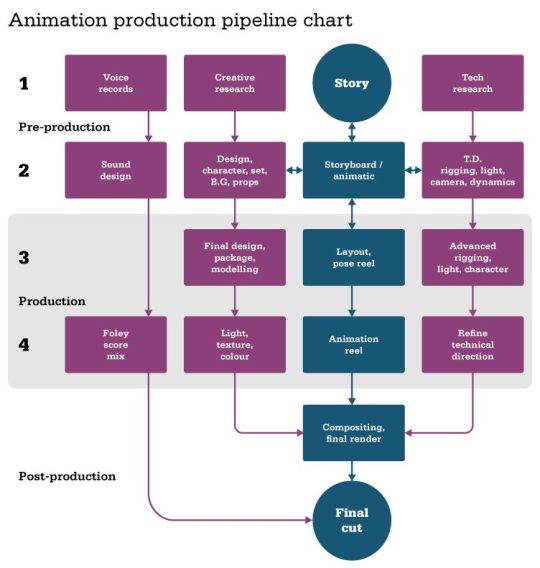
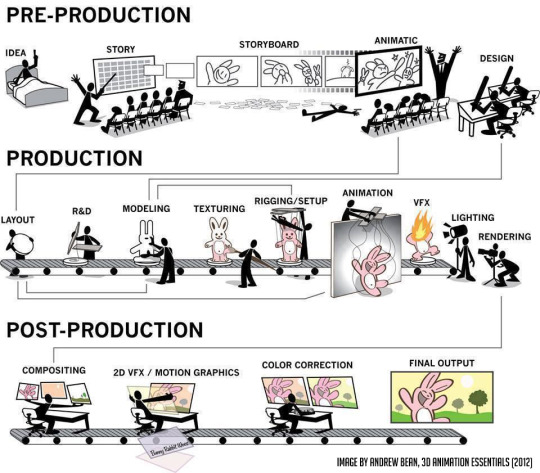
in order to get to a studio, without exceptional talent: you need to receive qualifications: There are various diploma courses to choose from; diploma in Graphic Designing, Web designing etc, which can help master the suite of technical skills required to pursue a lucrative career in this exciting and dynamic industry.
The curriculum for diploma courses are designed in such a manner that over a course of time students get a thorough grounding, expert training and certification in his/her desired topic of specialisation such as Modeling, Lighting, Rigging, Animation, Visual Effects etc.
A student pursuing a diploma course in animation and gaming can pursue a multitude of job roles, in leading animation studios and entertainment companies.
GETTING EMPLOYED - “HOW TO BECOME A SUCCESSFUL ANIMATOR”
youtube
It is tough to break into the industry, but if you work hard, make good connections, know how to network, and play your cards well, it’s not as hard as it might seem.
It also largely depends on what job within the umbrella of animation you choose to pursue. For example, getting the job of a character animator is much harder than getting a job as a technical director or pipeline tools developer.
Once you break into the industry though, it gets much easier, especially as you gain new skills and make more connections.
Your skills and portfolio is what will get you seen initially, but your connections and how much people like you is what will keep you hired throughout your career.
ALTERNATIVE ROUTES - “STARTING YOUR OWN ANIMATION PRODUCTION COMPANY”
Start-ups come in all shapes and sizes. Many are carefully planned right down to the tiniest details, while others seem to pop up overnight.
in other words, a right or wrong way to start an animation company might not exist. However, you’ll find no shortage of advice out there about what you can do if you need a little direction.
You begin by identifying the types of services you would like to offer.
Would you like to create short films? Create feature-length films? Animate for the advertising industry?
Next, create a working name, goals, and business plan.
You will also need to build a team - especially if you are planning to target the film and video industry. You will need to appoint an editor, director, designer and producer—to start.
If you have multiple skill sets, you might be just enough to start out on your own.
THE FUTURE OF THE INDUSTRY? https://businessofanimation.com/the-future-of-the-animation-industry/
The animation sector currently employs 56,800 people and employment is predicted to grow by 8% over the next 5 years. Employers have said that 25% of current vacancies are due to skills shortages across both 2D and 3D.
Productions employ a huge number of staff, many of whom will be freelance, to complete projects. 2014’s Paddington employed 893 people of whom 200-300 were animation artists.’
MORE STATISTICS:
78% of the workforce are educated to degree level.
27% of the workforce hold a postgraduate qualification.
Only 1% of the workforce have undertaken an apprenticeship.
56% of respondents had found out about their current or most recent role through informal recruitment.
Of those working in terrestrial TV 73% were likely to use formal classroom training. For both the games (53%) and the VFX (45%) workforces, online resources was the most commonly used mode of training.
We first saw animation in movies and shorts. Now, we see it in TV shows, ads, YouTube videos, social media, and video games.
THE VIDEOGAME INDUSTRY - “(PROVIDING) POWER TO THE PLAYER”
i love videogames - i grew up lucky enough to play as much as i did
but for someone who’s so passionate about playing - i have very little interest in getting into the production stages in this industry; and with a lack of interest, comes a lack of knowledge - but after an interesting lecture by Dr Paul Dolan; I wanted to do some further digging into some of the aspects he brought up, out of my own curiosity
so in the words of Nintendo's plumber let’s-a-go!

in order to talk about the industry, we need to understand a bit about how it works:

When the Machine Made Art: The Troubled History of Computer Art (2014) When the Machine Made Art covers the reception and criticism of computer art from its emergence in 1963 to its crisis in 1989, when ideological differences fragment the art movement. The text begins by identifying the various divisions between the humanistic and scientific cultures that inform early criticism.
THE HISTORY OF GAMING
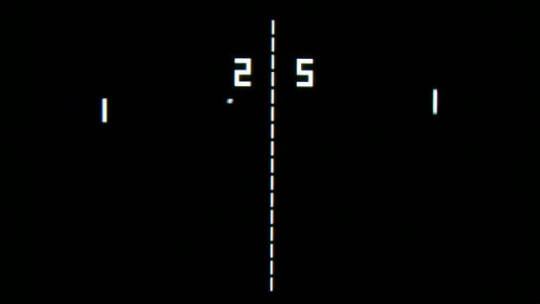
The first real video game wasn’t actually invented by the team at Atari, as is usually credited to Nolan Bushnell. No, that honor belongs to William Higinbotham.
In the 1950s, Higinbotham created “Tennis for Two”, as a fun diversion, to show the power of technology.
As is typical in history, the audience didn’t fully grasp the significance of videogames, believing it to be a waste of time - as back then, VideoGames were a “Rich-Man’s hobby”.
PRICING - “WHY WERE VIDEOGAMES SUCH AN EXPENSIVE MEDIA?”
youtube
a
BACK TO THE HISTORY LESSON..
1972: THE FIRST GENERATION OF CONSOLE GAMING - “DOTS AND DIALS”
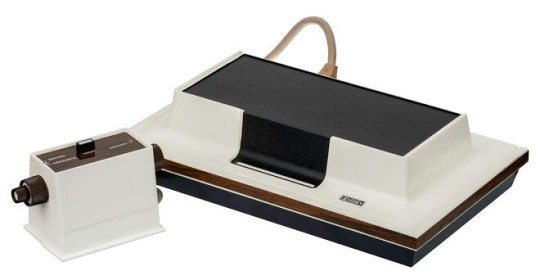
in 1972 - the idea of transforming your television set from a device you passively sit back and observe, into an interactive experience was unheard of.
but with the launch of the first commercial home video-game console, the Magnavox Odyssey, (invented by Ralph Baer.) home entertainment changed forever, as being able to play video games in one’s home; was a revolutionary idea - that we may take for granted today, as people used to have to journey to the local arcade, pizza parlor, or bowling alley to get their fix of games.
Odyssey games were composed of a maximum of three square dots and a single, vertical line - all monochrome - which was all the system was capable of generating. In an effort to add a little colour and variety, plastic overlays were provided, which could be placed directly onto the television screen.
Games were stored on printed circuit boards that plugged directly into the console, and to control the action, dials were used rather than buttons and a directional stick. Indeed the only button was the one to reset the game.
1970-1980 - “THE PEAK OF ARCADE GAMING”

Speaking of arcade games, the late 1970s and early 1980s experienced an impressive boom in popularity, bringing in serious commercial success.
This simple, yet addictive style of gaming, featured the player; not setting out to beat an objective, but going for the high score by surviving as long as possible - it was genius, these games were designed to suck up quarters: and thats exactly what happened~
“THE GREAT VIDEO-GAME CRASH OF ‘83″
As revolutionary as arcade games were, the gaming industry was facing a crisis: with the market being saturated, and the rise of PC gaming - arcade games started to become less interesting to many consumers, making sales and development suffer.
Was this to be the end of video games as we know them? It sure seemed like it.
From 1983 to 1985, the sheer volume of gaming options seemed to be muscling out arcade games, which experienced over 1500 closures, not to mention seriously suffering economic setbacks.
Luckily for us, the development of consoles like the Nintendo Entertainment System (NES) gave the market a big boost.
but with the introduction of consoles, to the mainstream - thus began one of gamings most current issues...
CONSOLE WARS BEGIN
youtube
CONTROVERSIES
much like any segment of an industry - there will always be controversies: heck even as recent as this year - several major companies have faced backlash for their treatment of employees
and I think it would be beneath me to name any of these companies. however, providing links to some articles on recent controversies within the animation and games industries for your own knowledge on the matters is not:
https://www.forbes.com/sites/teakvetenadze/2021/09/20/activision-blizzard-under-investigation-by-sec-over-allegations-of-workplace-discrimination/
0 notes